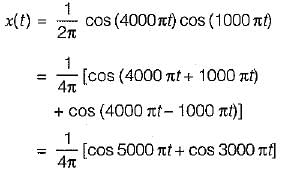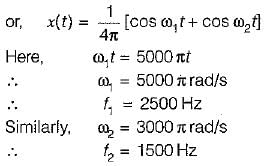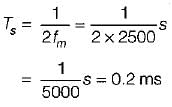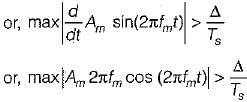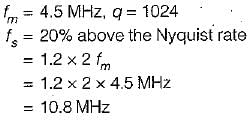Test: Pulse Modulation - Electronics and Communication Engineering (ECE) MCQ
10 Questions MCQ Test GATE ECE (Electronics) Mock Test Series 2025 - Test: Pulse Modulation
The Nyquist rate for a continuous-time signal (x) is
x(t) = 6cos50πt + 20sin300πt - 10cos100πt
x(t) = 6cos50πt + 20sin300πt - 10cos100πt
| 1 Crore+ students have signed up on EduRev. Have you? Download the App |
A telephone signal with cut-off frequency of 4 kHz is digitized into 8 bit PCM, sampled at Nyquist rate. The quantization S/N ratio is
A sine wave of frequency fm and amplitude Am is applied to a delta modulator having step size Δ. The slope overload distortion will not occur if
The output signal to noise ratio (SNR) of a 10-bit PCM was found to be 30 dB. The desired SNR is 42 dB. It was decided to increase the SNR to the desired value by increasing the number of quantization levels. The percentage increase in the transmission bandwidth required for this SNR is
The bandwidth of TV video plus audio signal is 4.5 MHz. If this signal is converted into PCM bit stream with 1024 quantization levels and the signal is sampled at the rate 20% above Nyquist rate, then the number of bits/sec of the resulting signal is
Assertion (A) : PCM has much better noise immunity as compared to PAM, PWM and PPM systems.
Reason (R) : PCM does not contain any information in the width or the position of the pulses.
Assertion (A) : The signaling rate and transmission channel bandwidth is quite large for delta modulation compared to PCM.
Reason (R) : There is no analog to digital converter required in delta modulation unlike PCM.
|
25 docs|263 tests
|
|
25 docs|263 tests
|







